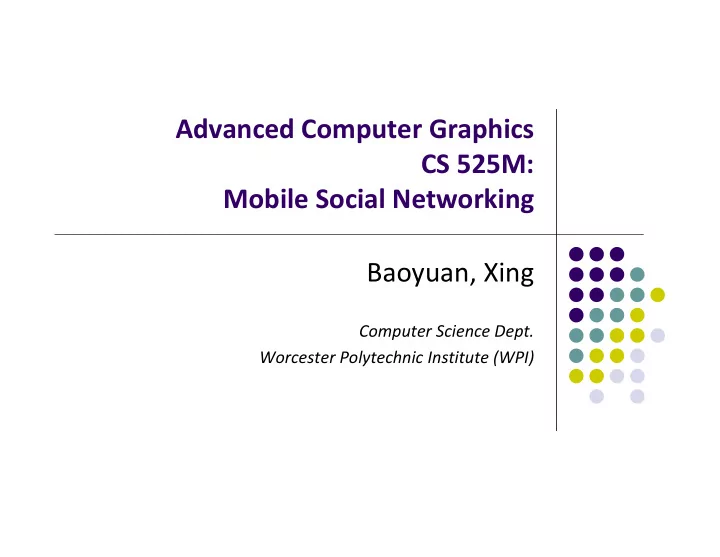

Advanced Computer Graphics CS 525M: Mobile Social Networking Baoyuan, Xing Computer Science Dept. Worcester Polytechnic Institute (WPI)
Bus arrival prediction system How long to wait for buses ??? For most city transport travelers, bus arrival time is primary information Schedule of a bus may be delayed due to many unpredictable factors (traffic jam, weather, etc) The accurate arrival time of next bus will mitigate travelers’ anxiety and improve their experience on the road
Related work Phone ‐ based transit tracking Automatic system for low cost, real ‐ time transit tracking, mapping and arrival time prediction using GPS collected by personal smartphones. Celltower sequence matching Comprehensive set of APIs with low GPS usage, high efficiency, robustness new data structure is presented for mobile application development Participatory sensing Many recent works develop participatory platforms for people ‐ centric mobile computing applications (Micro ‐ blog, SoundSense, SurroundSence, etc).
A novel bus arrival time prediction system based on crowd ‐ participatory sensing. Sharing users information collection to build database Querying users Request arrival time of interested route Backend server Data processing & Arrival time prediction
Bus detection : Am I on Bus? As aforementioned, database is built by sharing users. Information to verify whether sharing users are on a public transit bus is needed. Audio detection : using audio frequency analysis (128pt FFT) for IC reader beep. Accelerometer detection : measure acceleration to figure out whether users on the train or bus.
Bus classification Sharing users’ mobile phone samples a sequence of celltower IDs and reports the information to the backend server Celltower sequence matching Received celltower sequences are used for matching with stored sequences Celltower sequence concatenation For more accurate route classification, several sequences from different mobile phones on the same bus are concatenated
Arrival time prediction Arrival time of the bus at queried stop is estimated as : In general, where T i is the time for full block of cell tower; t k is time spent in current block; t q is time cost in last block
Performance of system Bus detection accuracy: Overall 95% within 3m from IC reader. Bus vs. MRT train classification: Round 90% at different time points Bus classification accuracy Round 90% (highest 96%, lowest 87%) accuracy for different 4 routes
Performance of arrival time prediction (b) shows mean errors of 4 routes (a) shows CDF of 4 routes, it indicates along with distance, it indicates mean error round 80 seconds mean error increase when distance increases.
Conclusion The crowd ‐ participated based system efficiently utilizes lightweight onboard sensors of cell phones, to predict the bus arrival time for users Over a 7 ‐ week experiment in Singapore, the evaluation demonstrate that the system can accurately predict the bus arrival time.(98% detection accuracy, arrival time error around 80 seconds)
Discussion and future work Number of celltowers a user could capture on a bus influences the bus classification accuracy WiFi points along the route might complement celltower ID First few bus stops Only using history data to generate a prediction arrival time Overlapped routes at downtown or major transit centers Challenging…
References [1] Bus transport in Singapore. http:// en.wikipedia.org/wiki/Bus_transport _in_Singapore. [2] EZ ‐ Link. http://www.ezlink.com.sg. [3] Octupus. http://www.octopus.com.hk/home/en. [4] Oyster. https://oyster.tfl.gov.uk/oyster. [5] PublicTransport@SG. http://www.publictransport.sg/. [6] T. Abdelzaher, Y. Anokwa, P. Boda, J. Burke,D. Estrin, L. Guibas, A. Kansal, S. Madden, and J. Reich. Mobiscopes for Human Spaces. IEEE Pervasive Computing, vol. 6(issue 2): pages 20–29, Apr. 2007. [7] G. Ananthanarayanan, M. Haridasan, I. Mohomed, D. Terry, and C. A. Thekkath. Startrack: a framework for enabling track ‐ based applications. In Proceedings of ACM MobiSys, pages 207–220, 2009.
Recommend
More recommend